
The following 16 exercises and more can be found at PhysioTherapy Exercises for people with injuries and disabilities. Even though most of the illustrations depict a para, these exercises are designed to help quads strengthen their arms and shoulders with the assistance of a physical therapist.
 1. Elbow extensor strengthening with pulleys
1. Elbow extensor strengthening with pulleys
Therapist’s aim: To strengthen the elbow extensors.
Your aim: To strengthen your triceps.
Therapist’s instructions: Position wheelchair user facing the pulleys. Adjust the pulley system so the direction of pull opposes elbow extension. Instruct the wheelchair user to extend their elbow.
Your instructions: Position yourself facing the pulleys. Adjust the pulley so the direction of pull is downwards from the ceiling. Start with your elbow bent and tucked in beside your body. Finish with your elbow straight.
Progressions and variations: More advanced: Progress using strength training principles.
 2. Elbow extensor strengthening with Thera-Band
2. Elbow extensor strengthening with Thera-Band
Therapist’s aim: To strengthen the elbow extensors.
Your aim: To strengthen your triceps.
Therapist’s instructions: Position the wheelchair user with their elbow flexed. Adjust the Thera-Band so the direction of pull opposes elbow extension. Instruct the wheelchair user to extend their elbow.
Your instructions: Position yourself facing the Thera-Band. Adjust the Thera-Band so the direction of pull is downwards from the ceiling. Start with your elbow bent and tucked in beside your body. Finish with your elbow straight.
Progressions and variations: Less advanced: Downgrade the color of the Thera-Band. More advanced: Upgrade the color of the Thera-Band.
 3. Elbow extensor strengthening in supine with free weights
3. Elbow extensor strengthening in supine with free weights
Therapist’s aim: To strengthen the elbow extensors.
Your aim: To strengthen your triceps.
Therapist’s instructions: Position the wheelchair user in supine with their shoulder flexed to 90 degrees and their elbow flexed. Instruct the wheelchair user to extend their elbow.
Your instructions: Position yourself lying on your back. Start with your shoulder held vertically and your elbow bent. Finish with your elbow straight.
Progressions and variations: More advanced: Progress using strength training principles.
 4. Elbow extensor strengthening in supine with Thera-Band
4. Elbow extensor strengthening in supine with Thera-Band
Therapist’s aim: To strengthen the elbow extensors.
Your aim: To strengthen your triceps.
Therapist’s instructions: Position the wheelchair user in supine with their elbow flexed. Adjust the Thera-Band so the direction of pull opposes elbow extension. Instruct the wheelchair user to extend their elbow.
Your instructions: Position yourself lying on your back. Adjust the Thera-Band so the direction of pull is from the top of the bed. Start with your arm beside you and your elbow bent. Finish with your elbow straight.
Progressions and variations: Less advanced: Downgrade the color of the Thera-Band. More advanced: Upgrade the color of the Thera-Band.
 5. Elbow extensor strengthening in supine with Thera-Band
5. Elbow extensor strengthening in supine with Thera-Band
Therapist’s aim: To strengthen the elbow extensors.
Your aim: To strengthen your triceps.
Therapist’s instructions: Position the wheelchair user in supine with their elbow flexed. Adjust the Thera-Band so the direction of pull opposes elbow extension. Instruct the wheelchair user to extend their elbow.
Your instructions: Position yourself lying on your back. Adjust the Thera-Band so the direction of pull is from the top of the bed. Start with your arm beside you and your elbow bent. Finish with your elbow straight.
Progressions and variations: Less advanced: Downgrade the color of the Thera-Band. More advanced: Upgrade the color of the Thera-Band.
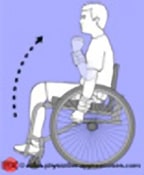 6. Elbow flexor strengthening with free weights
6. Elbow flexor strengthening with free weights
Therapist’s aim: To strengthen the elbow flexors.
Your aim: To strengthen your biceps.
Therapist’s instructions: Position the wheelchair user with their elbow and shoulder extended. Instruct the wheelchair user to flex their elbow.
Your instructions: Position yourself with your arm down beside your body. Start with your elbow straight. Finish with your elbow bent. Ensure you keep your elbow tucked in beside your body.
Progressions and variations: More advanced: Progress using strength training principles.
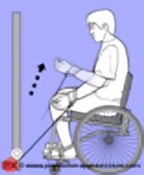 7. Elbow flexor strengthening with pulleys
7. Elbow flexor strengthening with pulleys
Therapist’s aim: To strengthen the elbow flexors.
Your aim: To strengthen your biceps.
Therapist’s instructions: Position the wheelchair user facing the pulleys. Adjust the pulley system so the direction of pull opposes elbow flexion. Instruct the wheelchair user to flex their elbow.
Your instructions: Position yourself facing the pulley. Adjust the pulley system so the direction of pull is upwards from the floor. Start with your elbow straight. Finish with your elbow bent.
Progressions and variations: More advanced: Progress using strength training principles.
Precautions: Ensure the wheelchair does not flip backwards.
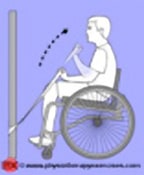 8. Elbow flexor strengthening with Thera-Band
8. Elbow flexor strengthening with Thera-Band
Therapist’s aim: To strengthen the elbow flexors.
Your aim: To strengthen your biceps.
Therapist’s instructions: Position the wheelchair user with their elbow extended. Adjust the Thera-Band so the direction of pull opposes elbow flexion. Instruct the wheelchair user to flex their elbow.
Your instructions: Position yourself facing the Thera-Band. Adjust the Thera-Band so the direction of pull is upwards from the floor. Start with your elbow straight. Finish with your elbow bent.
Progressions and variations: Less advanced: Downgrade the color of the Thera-Band. More advanced: Upgrade the color of the Thera-Band.
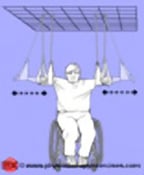 9. Elbow flexor/extensor strengthening with slings
9. Elbow flexor/extensor strengthening with slings
Therapist’s aim: To strengthen the elbow flexors/extensors.
Your aim: To strengthen your biceps and triceps.
Therapist’s instructions: Position the wheelchair user under an overhead cage with slings supporting their arms in shoulder abduction and elbow flexion. Instruct the wheelchair user to flex and extend their elbow.
Your instructions: Position yourself with slings supporting your arms. Start with your arms out to the side of your body and your elbows straight. Finish with your elbows bent.
Progressions and variations: More advanced: Progress using strength training principles.
 10. Shoulder extensor strengthening with pulleys
10. Shoulder extensor strengthening with pulleys
Therapist’s aim: To strengthen the shoulder extensors.
Your aim: To strengthen the muscles at the back of your shoulder.
Therapist’s instructions: Position the wheelchair user with an airsplint around their elbow and a pulley around their wrist. Adjust the pulley so the direction of pull opposes shoulder extension. Instruct the wheelchair user to extend their shoulder.
Your instructions: Position yourself with an airsplint around your elbow and a pulley around your wrist. Adjust the pulley so the direction of pull is downwards from the ceiling. Start with your arm in front of your body. Finish with your arm beside your body.
Progressions and variations: More advanced: Progress using strength training principles.
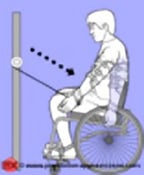 11. Shoulder extensor strengthening with pulleys
11. Shoulder extensor strengthening with pulleys
Therapist’s aim: To strengthen the shoulder extensors.
Your aim: To strengthen the muscles at the back of your shoulder.
Therapist’s instructions: Position the wheelchair user facing the pulleys. Adjust the pulley system so the direction of pull opposes shoulder extension. Instruct the wheelchair user to extend their shoulder with their elbow extended.
Your instructions: Position yourself facing the pulleys. Adjust the pulley system so the direction of pull is in alignment with the height of your shoulder. Start with your arm out in front of you. Finish with your arm beside your body. Ensure that you keep your elbow straight.
Progressions and variations: More advanced: Progress using strength training principles.
Precautions: Ensure the wheelchair does not flip backwards.
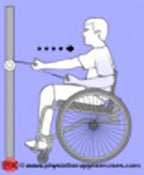 12. Shoulder extensor strengthening with pulleys
12. Shoulder extensor strengthening with pulleys
Therapist’s aim: To strengthen the shoulder extensors.
Your aim: To strengthen the muscles at the back of your shoulder.
Therapist’s instructions: Position the wheelchair user facing the pulleys. Adjust the pulley system so the direction of pull opposes shoulder extension. Instruct the wheelchair user to extend their shoulder and flex their elbow.
Your instructions: Position yourself facing the pulleys. Adjust the pulley system so the direction of pull is in alignment with the height of your elbow. Start with your arm out in front of you and your elbow straight. Finish with your elbow tucked beside your body and your elbow bent.
Progressions and variations: More advanced: Progress using strength training principles.
Precautions: Ensure the wheelchair does not flip backwards.
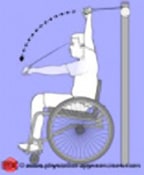 13. Shoulder extensor strengthening with pulleys
13. Shoulder extensor strengthening with pulleys
Therapist’s aim: To strengthen the shoulder extensors.
Your aim: To strengthen the muscles at the back of your shoulder.
Therapist’s instructions: Position the wheelchair user facing away from the pulleys. Adjust the pulley system so the direction of pull opposes shoulder extension. Instruct the wheelchair user to extend their shoulder with their elbow extended.
Your instructions: Position yourself facing away from the pulley. Adjust the pulley so the direction of pull is downwards from the ceiling. Start with your arm in front of your body. Finish with your arm down beside your body. Ensure that you keep your elbow straight.
Progressions and variations: More advanced: Progress using strength training principles.
Precautions: Ensure the wheelchair does not flip backwards.
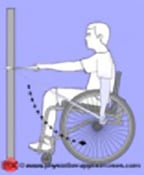 14. Shoulder extensor strengthening with Thera-Band
14. Shoulder extensor strengthening with Thera-Band
Therapist’s aim: To strengthen the shoulder extensors.
Your aim: To strengthen the muscles at the back of your shoulder.
Therapist’s instructions: Position the wheelchair user with their shoulder flexed. Adjust the Thera-Band so the direction of pull opposes shoulder extension. Instruct the wheelchair user to extend their shoulder while maintaining elbow extension.
Your instructions: Position yourself facing the Thera-Band. Adjust the Thera-Band so the direction of pull is downwards from the ceiling. Start with your arm out in front of you. Finish with your arm down beside your body. Ensure that you keep your elbow straight.
Progressions and variations: Less advanced: Downgrade the color of the Thera-Band. More advanced: Upgrade the color of the Thera-Band.
Precautions: Ensure the wheelchair does not flip backwards.
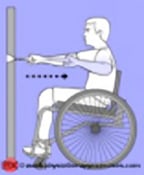 15. Shoulder extensor strengthening with Thera-Band
15. Shoulder extensor strengthening with Thera-Band
Therapist’s aim: To strengthen the shoulder extensors.
Your aim: To strengthen the muscles at the back of your shoulder.
Therapist’s instructions: Position the wheelchair user with their shoulder flexed. Adjust the Thera-Band so the direction of pull opposes shoulder extension. Instruct the wheelchair user to extend their shoulder and flex their elbow.
Your instructions: Position yourself sitting facing the Thera-Band. Adjust the Thera-Band so the direction of pull is aligned with your shoulder. Start with your arm out in front of you. Finish with your elbow bent and tucked in beside your body.
Progressions and variations: Less advanced: Downgrade the color of the Thera-Band. More advanced: Upgrade the color of the Thera-Band.
Precautions: Ensure the wheelchair does not flip backwards.
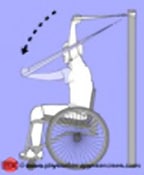 16. Shoulder extensor strengthening with Thera-Band
16. Shoulder extensor strengthening with Thera-Band
Therapist’s aim: To strengthen the shoulder extensors.
Your aim: To strengthen the muscles at the back of your shoulder.
Therapist’s instructions: Position the wheelchair user facing away from the pulleys. Adjust the pulley system so the direction of pull opposes shoulder extension. Instruct the wheelchair user to extend their shoulder with their elbow extended.
Your instructions: Position yourself facing away from the pulley. Adjust the pulley so the direction of pull is downwards from the ceiling. Start with your arm in front of your body. Finish with your arm down beside your body. Ensure you keep your elbow straight.
Progressions and variations: More advanced: Progress using strength training principles.
Precautions: Ensure the wheelchair does not flip backwards.
Support New MobilityWait! Before you wander off to other parts of the internet, please consider supporting New Mobility. For more than three decades, New Mobility has published groundbreaking content for active wheelchair users. We share practical advice from wheelchair users across the country, review life-changing technology and demand equity in healthcare, travel and all facets of life. But none of this is cheap, easy or profitable. Your support helps us give wheelchair users the resources to build a fulfilling life. |


Recent Comments
Bill on LapStacker Relaunches Wheelchair Carrying System
Phillip Gossett on Functional Fitness: How To Make Your Transfers Easier
Kevin Hoy on TiLite Releases Its First Carbon Fiber Wheelchair